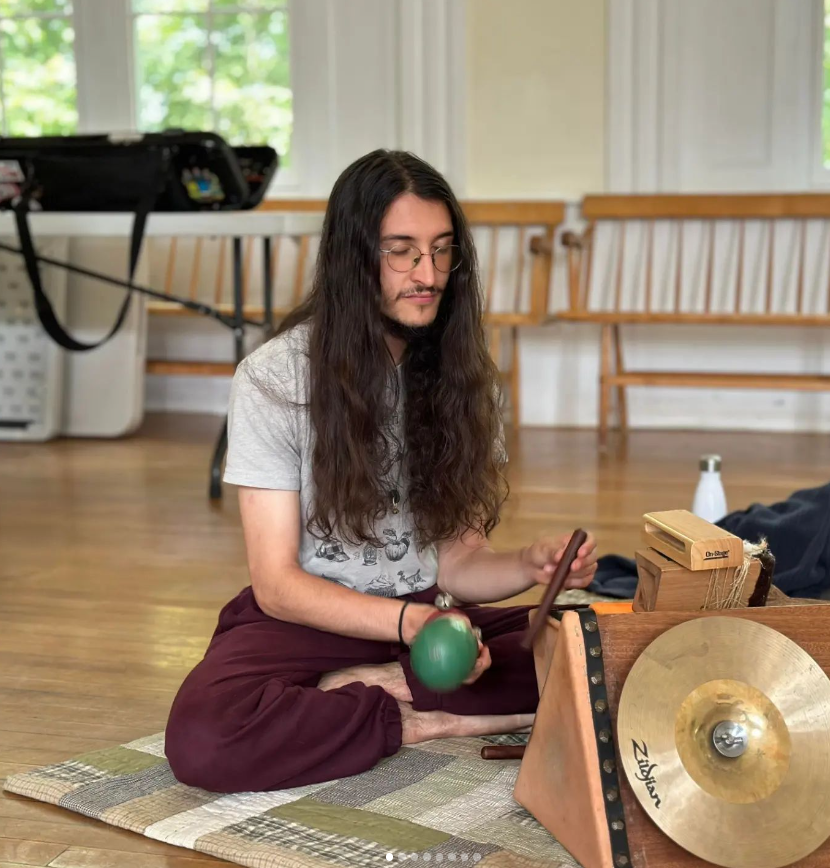Julian Calv – The Viking Of Sixth Avenue

1. Congratulations on the release of your limited edition 7″ vinyl single! Can you tell us more about the inspiration behind this project and the significance of carrying on the legacy of Moondog?
This project at it’s core is a debut of both my music and lifelong homage to Moondog. Route 4 and Thorn and Roots are what I consider place-based-compositions, as in they are inspired by a location. I moved to Woodstock Vermont in July of 2021 and while there I was renting an apartment right along the interstate Highway Route 4. Since moving to Vermont I’ve primarily found work as a musical artist by performing on the streets of a couple towns and doing concerts for small audiences. One such street is The Church St. Marketplace in Burlington, and I frequently set up in front of a juice bar called Thorn and Roots. These works are significant in the continuation of Moondog’s legacy as they are a contemporary reflection of the sound from Moondog’s more percussive music.
2. How has Moondog’s music and artistic vision influenced your own work as a multi-instrumentalist?
When it comes specifically to the multi-instrumentalist aspect I would say that Moondog’s ability to wield such a diverse musical sound was in part because of his capabilities as a multi-instrumentalist early in his career. This is intriguing. In his early albums you hear far more of his own invented instruments played together, and there’s a lot of freedom in that sound. As you move forward in the timeline of his recordings you realize the two original instruments that appear most commonly are the trimba and oo. Eventually it’s just the trimba and orchestral instruments. Moondog’s artistic vision originated from his own mind, so it evolved alongside him; my artistic vision picks up where he left off – the difference now though is that my vision originates from an already existing foundation of thoughts. All that being said though, I aim to wield a similarly diverse musical soundscape. Though I play many instruments, it’s mostly so I can understand them better when I write for other musicians who play them more proficiently than myself.
3. Can you share some insights into the creative process behind the single? How did you approach selecting and arranging the songs, and what was your goal in capturing the essence of Moondog’s style?
The process was a great joy. Route 4 found me sitting alongside the road for about two hours just me, a microphone, the computer, and a cup of coffee. I later recorded the trimba part at the 2Trax studio in New Jersey and then recorded all the other percussion parts at my apartment. Thorn and Roots was all composed on the spot during an improvisation in front of that same juice bar, and I recorded it in in the same sessions as Route 4 at 2Trax. My goal in capturing the Moondog essence was to combine my highly rhythmic music with the natural music of Earth and its human influence.
4. The vinyl format is known for its unique sonic and tactile qualities. How do you think this format enhances the listening experience of your music and adds to the overall artistic expression?
Vinyl is a physically transferred format of sound and honestly I’d go for this sound quality every chance I get. This music is based around the real physical world thus its delivered in a physical form, also most of Moondog’s initial releases were on vinyl. It acts as a type of icing on the cake sound quality that makes these recordings ever so slightly closer to emulating that authentic Moondog sound.
5. Are there any specific challenges or highlights you experienced while working on this project? How did you navigate the process of honoring Moondog’s legacy while also infusing your own musical voice into the single?
The continuous experimentation of the “Thorn and Roots” melody was a highlight for sure; playing around with the form a little differently each time, changing up some notes here and there. I’m eager to arrange this tune. Traditionally honoring Moondog’s legacy is no easy task. I consciously use the word traditionally since any and all music can be honored through its original timbres and composition or through reinterpretations – like a cover. It’s important we understand that because Moondog was blind much of the information regarding how to traditionally interpret and mimic his music has been communicated orally and not in script. Moondog is a composer who did not want his music reinterpreted because, he wanted it to be perpetuated as it was in its original conception. I was a student and close friend of Moondog’s only student Stefan Lakatos, and from this relationship have a heightened understanding of this music that’s been preserved directly from the source. The foundation of “Route 4” and “Thorn and Roots” are in the trimba grooves, which are played identically to how Moondog would play them. “Route 4” is in the 5/4 time signature with an accent on beats one and four, creating a rhythmic grouping of three plus two. Similarly “Thorn and Roots” is in 7/4 with an accent on beats one, three, and six, creating a rhythmic grouping of two plus three plus two.
6. Is there a particular song on the single that you feel especially connected to or proud of? Could you share the story behind it and why it resonates with you?
“Route 4” holds a special place in my heart. That apartment along the interstate was the first place I lived in right after I graduated from university and the hum of those cars were my lullaby. I feel as if that song puts yourself in the position of one of my neighbors, hearing both the interstate and my primitive drumming.
7. How do you feel your own music has evolved or progressed since delving into Moondog’s work? Are there any new elements or influences that you’ve incorporated into your sound as a result?
It’s definetly evolved into a more distinct voice. My earlier compositions throughout my years at university have a more experimental atmosphere to them, some tonal, some atonal, some atmospheric, etc. No recordings of these pieces exist aside from a couple on my hard drive. Music which I currently write has a far more deliberate harmonic language to it, and draws heavily from the Western European counterpoint traditions.
8. As a multi-instrumentalist, how do you approach the task of playing different instruments and merging their sounds harmoniously? What challenges and rewards come with mastering multiple instruments?
I would say the approach is curious and based on what has been done by others that I can hear. I know what timbres I like together and which ones I don’t. Currently in live performance I find myself playing the trimba, singing, playing the balafon, sometimes melodica or recorder, and on occasion ukuleles or three string cigar box guitars. I’d never consider myself a master of the other instruments I have played – bass clarinet, euphonium, krummhorn, etc. – but as a composer I have a firm grasp on what can and can not be done on such instruments.
9. What do you hope listeners will take away from this limited edition single? How do you think it contributes to the preservation and appreciation of Moondog’s legacy?
I hope listeners take a part of the landscape I once found myself in along with them. I seek to present an alternate way to appreciate the nuance of a daily sonic atmosphere. I believe there were times in Moondog’s life where he felt very similar, and thus I preserve another inspirational tool of his craft.
10. What are your plans for the future in terms of continuing to pay tribute to Moondog’s music and exploring your own musical path? Are there any upcoming projects or collaborations that we can look forward to?
Currently I am in the process of preparing an album titled Nonstop Motion. It will have both Moondog songs and Julian songs, and will debut some never before recorded songs from both of us. The album will feature the piano playing of Pennsylvania based pianist and composer Ava Bloomfield along with my trimba playing. Aside from that I have a few shows coming up in the state of Vermont, and any information regarding them can be found on my social media outlets.
For more information:
www.instagram.com/julian.trimba/
www.dekoentertainment.com


